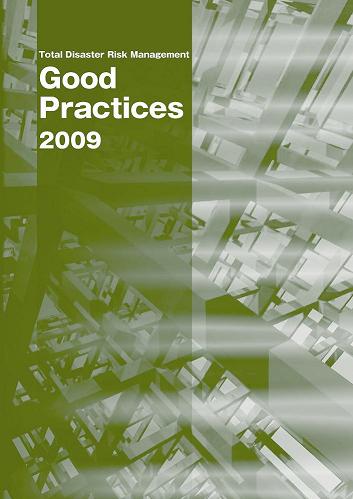|
Contents
All the files are compiled in the "PDF" format.

|
Total Disaster Risk Management
- Good Practices 2009 -

Foreword
On average, approximately 200 million people have been affected by natural disasters every year around the
world in recent decades. Most notably, the Sichuan Earthquake in China and tropical cyclone Nargis?both
occurring in May 2008?resulted in a large degree of victims and damage. In 2009, a plethora of natural
disasters again hit countries across Asia, such as earthquakes in Indonesia and typhoons in the Philippines or
elsewhere, reminding us of the ever-growing need for cooperation in disaster relief, recovery, and rehabilitation,
as well as for pre-disaster measures, such as disaster mitigation or awareness-raising.
Countries around the world along with international organizations, such as the UN, have been doing their
utmost to implement the Hyogo Framework for Action 2005?2015: Building the Resilience of Nations and
Communities to Disasters (HFA). Efforts to reduce disaster risks should be an integral part of the sustainable
development process, such that international organizations, governments, private enterprises, NGOs, academics,
and other entities concerned must work together to implement the five priorities for action adopted in the HFA.
Since its inception in 1998, the Asian Disaster Reduction Center (ADRC) has been pursuing safety and security
for those living in Asia through various means, including information sharing, human resource development,
and community capacity-building. Further along this line, the ADRC has been collaborating with the UN and
other international organizations/disaster management institutions in each country toward implementing the
HFA.
This booklet, gTotal Disaster Risk Management: Good Practices,h has been published annually since January
2005, when the United Nations World Conference on Disaster Reduction was held in Kobe, Hyogo, Japan.
It is intended as a user-friendly publication and aims to further promote disaster risk reduction activities by
demonstrating positive examples collected from different countries.
I hope that Good Practice 2009 will be widely used by policymakers, parishioners, and many others, thereby
contributing to the realization of gBuilding the Resilience of Nations and Communities to Disasters.h
Foreword
Contents 
1 Armenia 
Building Disaster-Resilient Communities in Armeniafs Mountainous Areas through Dam Safety and Risk
Reduction Measures
2 India
Good Practices in Landslide Risk Management
- An Example from Uttarkashi, Uttrakhand State, India
3 Indonesia
- Integrated Monitoring Enables Good Early Warning:
The 2007 Kelud Volcano Crisis in Indonesia
- The Role of the Quick Response Team During Volcanic Crises in Indonesia
4 Japan
EBuilding Public-Private Partnerships to Ensure Safe Gas Use
EChallenges at the Kiyomizu Temple and Surrounding Area
EGlass Power Campaign: Activities for Widespread Use of Disaster-Resistant Glass
EThe gCommunity-based Disaster Reduction: Map Simulationh Program
Local Disaster Reduction Activities Utilizing Large Neighborhood Maps
EThe gInamura no Hi h Puppet Show Project
- Activities and Achievements -
EWhat Companies Have Learned from Experience
5 Kyrgyz Republic
EDisaster Risk Mitigation with Local Community Participation
EEstablishment of Volunteer Rural Rescue Teams in Vulnerable Communities
6 Mongolia
Disaster Risk Reduction - Good Practice
7 Singapore 
Exercise Northstar VI .
8 Thailand
Disaster Risk Reduction- Good Practice
|

